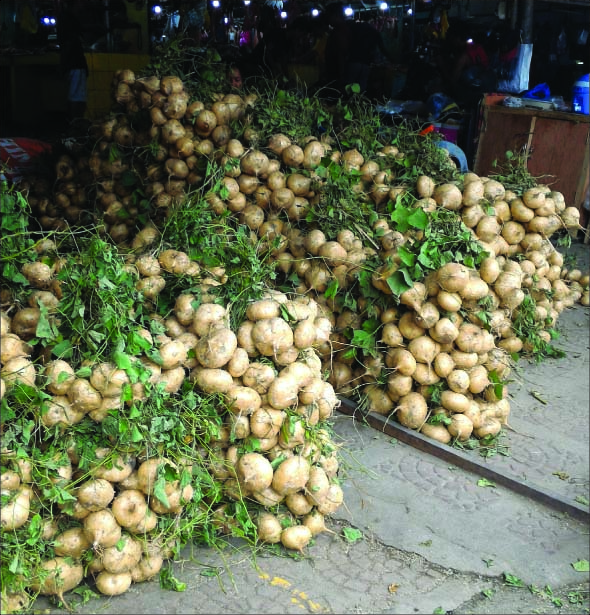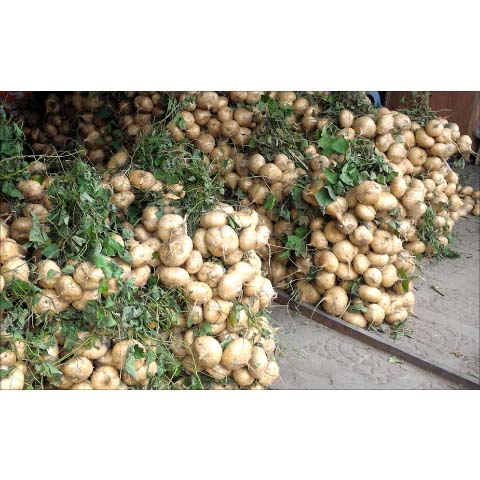 For many years I lived in North America, where tropical produce are priced at a premium, if they are sold at all in the neighborhood supermarket. Imagine my delight when we moved to the desert state of Arizona, and found singkamas in a grocery store. Its crisp white flesh, sweet and juicy, was a welcome change for a palate jaded by native North American produce: broccoli, carrots, spinach, tomato… you get the picture.
For many years I lived in North America, where tropical produce are priced at a premium, if they are sold at all in the neighborhood supermarket. Imagine my delight when we moved to the desert state of Arizona, and found singkamas in a grocery store. Its crisp white flesh, sweet and juicy, was a welcome change for a palate jaded by native North American produce: broccoli, carrots, spinach, tomato… you get the picture.
Also called jicama, the turnip is native to Mexico and eaten throughout South America. It reportedly arrived in the Philippines courtesy of the Spanish, and has worked its way onto the Filipino dinner table and to kitchens in China and Southeast Asia.
It is singkamas season here in Manila. Cheap and plentiful this time of year, singkamas can be eaten raw, dipped in nutritious hummus, salsa or guacamole, or sprinkled with salt and calamansi juice. It can be sliced and tossed with a green salad to add a low-calorie crunch, or julienned and lightly stir fried – just like water chestnuts – with other vegetables.
While I prefer my vegetables crisp and – often – raw, other people serve baked singkamas with meat instead of baked potato, thus reducing the meal’s starch and caloric value. Great for those on a weight-loss diet.
Nutrition
Eaten peeled, singkamas is said to be good for you in many ways. A quick browse through the internet tells us one cup of sliced singkamas offers these nutritional benefits:
Fiber. It has only 49 calories. Yet, its 6.4 grams of dietary fiber provides 16 percent of the daily requirement for men, and 25 percent for women. Fiber helps move things along the digestive tract and prevents constipation. It also helps lower cholesterol levels and weight loss. Singkamas is also a rich source of soluble fiber which does not turn into sugar, letting diabetics satisfy that sweet tooth without worrying about blood sugar levels.
Vitamin C. Apparently, 100 grams of singkamas fulfills 40 percent of our daily dietary need for ascorbic acid. Vitamin C also stimulates the white blood cells which in turn gives the immune system a boost. Vitamin C is also an antioxidant, which promotes overall health.
Minerals. It has a good amount of copper and iron, which are essential to healthy red blood cells. Without them, people can suffer from anemia. As well, a cup of this root yields 195 milligrams of potassium, the same amount one gets in a peach. Potassium is an electrolyte that counteracts the effects of sodium, thus helping to control blood pressure to lower the risk of stroke. It protects against loss of muscle mass and bone density. It also reduces the formation of kidney stones.
Vitamin B. A cup of singkamas offers about 16 percent of our daily folic acid requirement. Folic acid helps the body produce and maintain new cells, specially red blood cells.
Beware the side effects
The singkamas may seem like an all-around superfood, but beware of side effects. Its skin, flowers and vine contain rotenone, a natural insecticide to protect it from pests. On humans, rotenone is toxic. The seed pods apparently can be eaten when young, but the mature pods are toxic. So err on the side of caution and eat only the tuberous root peeled… always.
With the onset of summer and hot days, a plate of cold singkamas, peeled and sliced, makes a thirst quenching, nutritious snack, or a satisfying crispy finale to a healthy meal.
